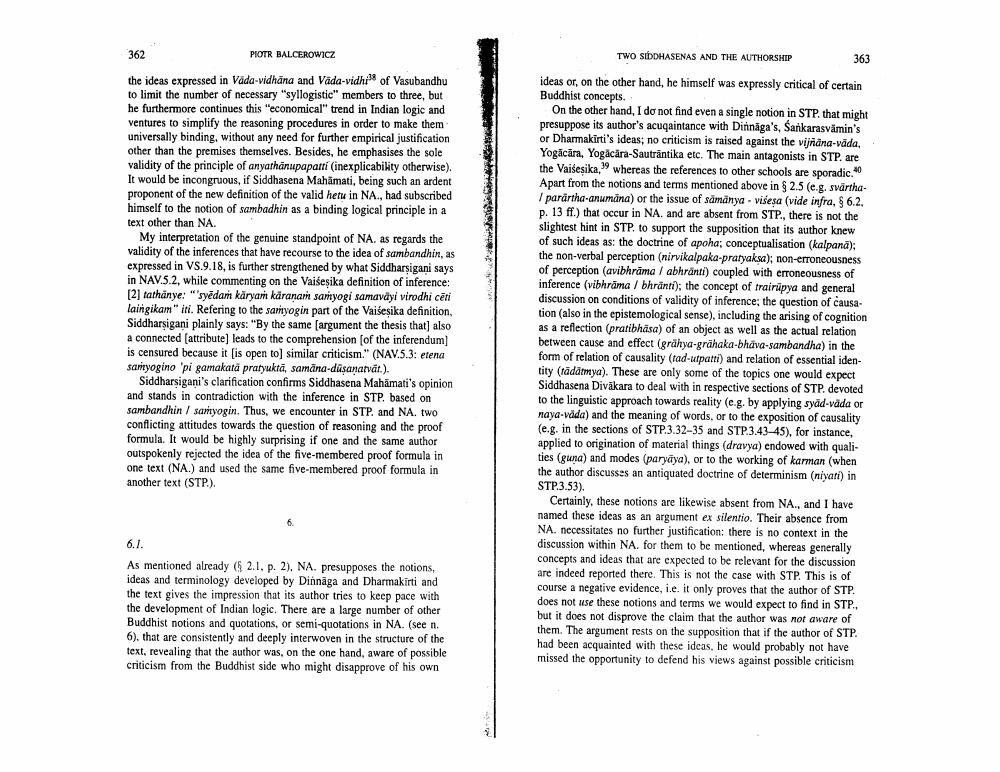________________
TWO SÚDDHASENAS AND THE AUTHORSHIP
PIOTR BALCEROWICZ
362
363
11
tor
the ideas expressed in Vada vidhana and Vada-vidhi of Vasubandhu to limit the number of necessary "syllogistic" members to three, but he furthermore continues this "economical trend in Indian logic and ventures to simplify the reasoning procedures in order to make them universally binding. without any need for further empirical justification other than the premises themselves. Besides, he emphasises the sole validity of the principle of anyathanupaparti inexplicability otherwise). It would be incongruous, if Siddhasena Mahamati, being such an ardent proponent of the new definition of the valid hetu in NA, had subscribed himself to the notion of sambadhin as a binding logical principle in a text other than NA
My interpretation of the genuine standpoint of NA, as regards the validity of the inferences that have recourse to the idea of sambandhin, as expressed in VS.9.18, is further strengthened by what Siddharsigani says in NAV.5.2, while commenting on the Vaiseșika definition of inference: [2] tathänye: ''syēdam karyar karanam samyogi samaväyi virodhi ceri laingikam" ini. Refering to the sariyogin part of the Vaišesika definition Siddharsigani plainly says: "By the same (argument the thesis that also a connected (attribute) leads to the comprehension (of the inferendum is censured because it is open to similar criticism." (NAV.5.3: etena santyogino 'pi gamakata praryukta, samāna-dasanarvär.).
Siddharsigani's clarification confirms Siddhasena Mahamati's opinion and stands in contradiction with the inference in STP. based on sambandhin / sarityogin. Thus, we encounter in STP. and NA, two conflicting attitudes towards the question of reasoning and the proof formula. It would be highly surprising if one and the same author outspokenly rejected the idea of the five-membered proof formula in one text (NA.) and used the same five-membered proof formula in another text (STP).
ideas or, on the other hand, he himself was expressly critical of certain Buddhist concepts.
On the other hand, I do not find even a single notion in STP. that might presuppose its author's acuqaintance with Dinnāga's, Sankarasvamin's or Dharmakirti's ideas, no criticism is raised against the viridna-vada, Yogacara, Yogacara-Sautrantika etc. The main antagonists in STP. are the Vaišesika," whereas the references to other schools are sporadic." Apart from the notions and terms mentioned above in $ 2.5 (e.g. svārthaI parartha-anumäna) or the issue of sämänya - višesa (vide infra, $ 6.2, p. 13 ff.) that occur in NA. and are absent from STP., there is not the slightest hint in STP. to support the supposition that its author knew of such ideas as: the doctrine of apoha, conceptualisation (kalpana); the non-verbal perception (nirvikalpaka-pratyaksa); non-erroneousness of perception (avibhrama / abhranti) coupled with crroneousness of inference (vibhrama/bhränti); the concept of trairüpya and general discussion on conditions of validity of inference, the question of causation (also in the epistemological sense), including the arising of cognition as a reflection (pratibhāsa) of an object as well as the actual relation between cause and effect (grāhya-grähaka-bhava-sambandha) in the form of relation of causality (tad-utpatti) and relation of essential identity (tādātmya). These are only some of the topics one would expect Siddhasena Diväkara to deal with in respective sections of STP. devoted to the linguistic approach towards reality (e.g. by applying sydd-vada or naya-voda) and the meaning of words, or to the exposition of causality (e.g. in the sections of STP.3.32-35 and STP.3.43-45), for instance, applied to origination of material things (dravya) endowed with qualities (guna) and modes (paryāya), or to the working of karman (when the author discusses an antiquated doctrine of determinism (niyatl) in STP.3.53).
Certainly, these notions are likewise absent from NA., and I have named these ideas as an argument ex silentio. Their absence from NA. necessitates no further justification: there is no context in the discussion within NA, for them to be mentioned, whereas generally concepts and ideas that are expected to be relevant for the discussion are indeed reported there. This is not the case with STP. This is of course a negative evidence, i.e. it only proves that the author of STP. does not use these notions and terms we would expect to find in STP.. but it does not disprove the claim that the author was not aware of them. The argument rests on the supposition that if the author of STP. had been acquainted with these idcas, he would probably not have missed the opportunity to defend his views against possible criticism
6.1.
As mentioned already (5 2.1. p. 2), NA. presupposes the notions, ideas and terminology developed by Dinnaga and Dharmakirti and the text gives the impression that its author tries to keep pace with the development of Indian logic. There are a large number of other Buddhist notions and quotations, or semi-quotations in NA. (see n. 6), that are consistently and deeply interwoven in the structure of the text, revealing that the author was, on the one hand, aware of possible criticism from the Buddhist side who might disapprove of his own




